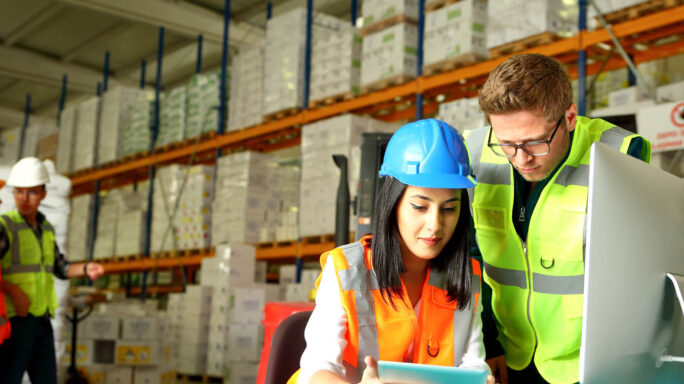EORI number: How to apply and trade with the UK post-Brexit
Not sure what an EORI number or what it means for your business post-Brexit? Find out how to apply for one and trade with the UK.

Not sure what an EORI number or what it will mean for your business post-Brexit?
Brexit occurred at the end of January 2020 and a UK-European Union (EU) trade deal was reached before the transition period ended on 31 December 2020.
Now, businesses that import from or export goods to the UK need to have an Economic Operator Registration and Identification (EORI) number.
You need to register for an EORI number if you haven’t already done so.
The EORI will then be used on the customs and VAT declarations that businesses need to create when trading with businesses in the UK.
Application is via the Office of the Revenue Commissioners.
Irish businesses need to act now. This article will help you take the steps to do so – it covers the following topics:
Does my business need an EORI number after Brexit?
Does my business have an EORI number?
Does my business have to apply for an EORI number?
Can I assume my business already has an EORI number?
My business has an EORI number already within the UK. Do I need an Irish EORI number?
Does my services business need an EORI number after Brexit?
What is the EORI application process and what details do I need?
How long does it take to get an EORI number?
Can I find an EORI number by company name?
My business is UK-based (including being based in Northern Ireland). How do I apply for an EORI?
Advice for exporting goods to the EU after Brexit
What is an EORI number?
An EORI number is an EU requirement for businesses that want to import or export physical goods with countries in instances where the trade could involve tariffs being applied by customs.
Note that customs tariffs are different to VAT. Assuming the goods you import or export are liable, VAT will be collected in addition to tariffs and also collected in a different way.
An EORI number wasn’t required prior to the end of 2020 for the majority of businesses that traded with the UK because, as a member of the EU, the UK was part of a free trade area. Tariffs didn’t apply.
An Irish company’s EORI number is very likely to be the same as its Value Added Tax (VAT/CBR) identification number, so will look something like IE1234567K. Or it might be IE followed by your business tax reference number.
In the unlikely event a business isn’t VAT-registered then its Customs & Excise (C&E) number might have been used instead.
For businesses in Northern Ireland or the rest of the UK, an EORI takes the form a 12-digit number that begins with GB. As such, it is very similar to a UK VAT number, although longer.
However, businesses that move goods between Northern Ireland and non-EU countries (including the UK) will need a second EORI number, beginning with XI. The UK government is only issuing these to businesses that have already got an GB-series EORI number.
The EORI number needs to be quoted in documentation such as customs declarations and clearances, and is used by computerised customs systems as an identifier. It is used in some VAT documentation too.
The EU has a database of EORI numbers, and the UK will share its own database with the EU at some point in the future.
If a business plans to use customs agents, freight forwarders or couriers to complete customs declarations on their behalf, the agents will need to know the EORI number to complete the paperwork.
If there is no EORI number, goods may be held up for customs clearance.
Does my business need an EORI number after Brexit?
If your business imports or exports goods with the UK then it’s likely it will need an EORI number. It doesn’t matter about the size of the business undertaking this trading. Sole traders, partnerships and bigger companies will all need one.
One notable exception relates to any business based in Northern Ireland (that is, a UK-based business).
If it trades only with the Republic of Ireland then it will not need an EORI number. This is because Northern Ireland effectively remains within the EU customs and VAT areas.
Does my business have an EORI number?
You can check quickly and easily using the European Commission’s EORI Number Validation website. Simply type IE, followed by your business’ VAT number (removing any spaces between letters and numbers).
For example, if your VAT number is 1234567 then you would type:
IE1234567
And then click the Validate button.
If what you typed is shown in the results as valid, then you have a valid EORI number. Note that you will probably not see your company’s details listed alongside.
Does my business have to apply for an EORI number?
You will not automatically be assigned an EORI, so will have to apply for one if your business requires it.
(Note that many UK businesses have automatically issued with an EORI number by the UK government in preparation for Brexit, but this does not apply to Irish businesses.)
However, your business might already have an EORI if it was in existence before 2009 and was registered for customs and excise at that time.
When the EORI system was introduced in 2009, Revenue automatically assigned numbers to businesses it thought would need them.
Your business would have been informed about this but understandably may have lost the documentation in the decade since.
Can I assume my business already has an EORI number?
Although an EORI number typically comprises a company’s VAT number plus IE appended to the front, you must apply with Revenue as described below to officially register with Customs & Excise (C&E), and to both receive and make use of an officially sanctioned EORI number.
My business has an EORI number already within the UK. Do I need an Irish EORI number?
You won’t be able to register online for an EORI if you already have one from another EU member state (including the UK in this instance).
You should contact Revenue’s eCustoms helpline for advice.
Does my services business need an EORI number after Brexit?
The requirement only applies to moving goods. If your business imports or exports services, and doesn’t move physical goods across borders, it will not need an EORI.
Although the term Mini One-Stop Shop (MOSS) applies to VAT, any true MOSS business that trades only digital services will also not require an EORI (although note that it’s not be possible to use MOSS with UK businesses now the UK’s Brexit transition period has finished).
What is the EORI application process and what details do I need?
You can apply online and will require an existing Revenue Online Service (ROS) account, including a valid ROS digital certificate. If you haven’t already got a ROS, you’ll first need to apply for one. The process will require your company’s Tax Registration Number.
After logging into your company’s ROS account, the steps required are listed in a Revenue guide but, in summary, you’ll need to login and register for Customs & Excise (C&E).
You should tick the box headed “Will you be importing/exporting goods to/from the EU?”, which might sound confusing. However, Ireland is, of course, part of the EU and your intention is therefore to import or export goods to/from the EU.
You will also be shown an option about whether to publish your EORI number publicly. This is advisable and will help traders in the UK discover this detail without which they will be unable to complete customs paperwork.
To do so, they will be able to search by your company name in the European Commission’s EORI database (see “Can I find an EORI number by company name?” below).
How long does it take to get an EORI number?
You will be shown your EORI number during the application process, as discussed above.
Once you click the Sign & Submit button at the end of the application process, you are registered for C&E/EORI and can start using the number immediately for customs declarations in Ireland.
However, it will take up to 24 hours for the number to appear in the European Commission’s database of EORI numbers.
Can I find an EORI number by company name?
For businesses within the EU, there is no reliable way to see the name of an organisation linked to an EORI number but some countries do provide systems that show this information.
For Irish businesses for which you know the VAT number, you can use the Economic Operator Identification and Registration system checking tool, as mentioned earlier.
This is designed to show if an EORI number is valid, which means it is in the right format and has been issued to an organisation.
However, because Irish EORI numbers are usually the same as the company’s VAT number, you can use the tool to search by business if you know their VAT number.
Just precede the VAT number with IE.
For example, if the VAT number is 2782636PA then you would enter IE2782636PA. Then click the Validate button.
If you see a message saying “This EORI number is not valid”, then the business probably doesn’t have an EORI number.
(Although as mentioned above, a minority of businesses were assigned their C&E number as their EORI back in 2009—if you know the C&E number for the business, you might attempt to validate that in the tool mentioned above, again preceding it with IE.)
If the business has opted to publish its company name along with its EORI then you might be able to search for this using the website discussed earlier. However, this is not currently commonplace.
Alternatively, you might contact Revenue’s eCustoms helpline.
My business is UK-based (including being based in Northern Ireland). How do I apply for an EORI?
See our separate EORI article for UK-based businesses but, in general, you will need a GB-series EORI number, and an XI-series number.
Both are issued by HMRC, the UK’s government’s tax and customs agency.
Advice for exporting goods to the EU after Brexit
Revenue advises that businesses need to focus on three areas for trading with the UK following Brexit:
- Getting an EORI number, as discussed above
- Understanding how to make a customs declaration
- Knowing the Commodity Code for the goods or products your business imports or exports. Note that the UK Global Tariff might apply to exports to the UK.
Editor’s note: This article was first published in December 2019 and has been updated for relevance.
7 ways to take control of your business
Want to know how you can boss it at your business? Read this guide for top tips to help you master your business admin and truly take control.







Ask the author a question or share your advice